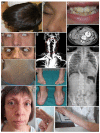Genotypic Categorization of Loeys-Dietz Syndrome Based on 24 Novel Families and Literature Data
- PMID: 31569402
- PMCID: PMC6826414
- DOI: 10.3390/genes10100764
Genotypic Categorization of Loeys-Dietz Syndrome Based on 24 Novel Families and Literature Data
Abstract
Loeys-Dietz syndrome (LDS) is a connective tissue disorder first described in 2005 featuring aortic/arterial aneurysms, dissections, and tortuosity associated with craniofacial, osteoarticular, musculoskeletal, and cutaneous manifestations. Heterozygous mutations in 6 genes (TGFBR1/2, TGFB2/3, SMAD2/3), encoding components of the TGF-β pathway, cause LDS. Such genetic heterogeneity mirrors broad phenotypic variability with significant differences, especially in terms of the age of onset, penetrance, and severity of life-threatening vascular manifestations and multiorgan involvement, indicating the need to obtain genotype-to-phenotype correlations for personalized management and counseling. Herein, we report on a cohort of 34 LDS patients from 24 families all receiving a molecular diagnosis. Fifteen variants were novel, affecting the TGFBR1 (6), TGFBR2 (6), SMAD3 (2), and TGFB2 (1) genes. Clinical features were scored for each distinct gene and matched with literature data to strengthen genotype-phenotype correlations such as more severe vascular manifestations in TGFBR1/2-related LDS. Additional features included spontaneous pneumothorax in SMAD3-related LDS and cervical spine instability in TGFB2-related LDS. Our study broadens the clinical and molecular spectrum of LDS and indicates that a phenotypic continuum emerges as more patients are described, although genotype-phenotype correlations may still contribute to clinical management.
Keywords: Ehlers-Danlos syndrome; Loeys-Dietz syndrome; SMAD2; SMAD3; TGFB2; TGFB3.; TGFBR1; TGFBR2; arterial aneurysms; hereditary connective tissue disorders.
Conflict of interest statement
All authors declare that there is no conflict of interest concerning this work.
Figures

References
-
- Loeys B.L., Chen J., Neptune E.R., Judge D.P., Podowski M., Holm T., Meyers J., Leitch C.C., Katsanis N., Sharifi N., et al. A syndrome of altered cardiovascular, craniofacial, neurocognitive and skeletal development caused by mutations in TGFBR1 or TGFBR2. Nat. Genet. 2005;37:275–281. doi: 10.1038/ng1511. - DOI - PubMed
-
- Van de Laar I.M., Oldenburg R.A., Pals G., Roos-Hesselink J., de Graaf B., Verhagen J., Hoedemaekrs Y., Willemsen R., Severijnen L., Venselaar H., et al. Mutations in SMAD3 cause a syndromic form of aortic aneurysms and dissections with early-onset osteoarthritis. Nat. Genet. 2011;43:121–126. doi: 10.1038/ng.744. - DOI - PubMed
Publication types
MeSH terms
Substances
LinkOut - more resources
Full Text Sources

